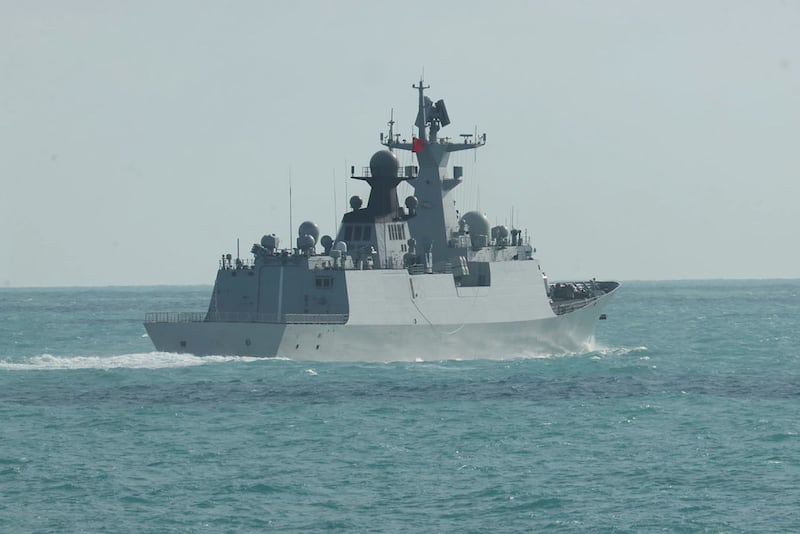Australia and China traded blame over an incident above the disputed Paracel archipelago in the South China Sea, adding to an already volatile situation in the region.
On Feb. 11, a Royal Australian Air Force P-8A Poseidon maritime patrol aircraft experienced an “unsafe and unprofessional interaction” with a Chinese J-16 fighter aircraft, the Australian Defence Force, or defense department, said in a statement Thursday.
The P-8A Poseidon was conducting a routine maritime surveillance patrol in the South China Sea at the time, it said.
Australia said the Chinese aircraft had released flares close to the Australian aircraft.
“This was an unsafe and unprofessional maneuver that posed a risk to the aircraft and personnel,” the Australian department said.
No crew member was injured in the incident and the aircraft was not damaged but Australia said it “expects all countries, including China, to operate their militaries in a safe and professional manner.”
Australian Defense Minister Richard Marles told Sky News that the Chinese J-16 was “so close that there’s no way you could have been able to ensure that the flares did not hit the P-8.”
“Had any of those flares hit the P-8, that would have definitely had the potential for significant damage to that aircraft,” he said.
Flares, when fired at an aircraft at close proximity, could get into the engine and cause the plane to crash. Yet they are regularly used by the People’s Liberation Army Air Force against foreign assets.
In May 2024, Australia protested to China after one of its fighter jets intercepted and dropped flares close to an Australian helicopter in international waters in the Yellow Sea.
In late October 2023, a Chinese warplane also used flares against a Canadian shipborne maritime helicopter over the South China Sea.
RELATED STORIES
South China Sea: 5 things to watch in 2025
Vietnam builds islands in South China Sea amid tension, challenges
South China Sea: Massive chunk of coral reef destroyed by island-building rivals
Disputed Paracel islands
China rejected Australia’s latest complaint, saying the Australian military aircraft “deliberately intruded into China’s airspace over Xisha Qundao.”
The archipelago that China calls Xisha, known internationally as the Paracel islands, is claimed by China, Vietnam and Taiwan.
It has been under Beijing’s control since 1974 when Chinese troops took it from South Vietnam in a battle that killed 74 Vietnamese sailors.
Chinese foreign ministry spokesperson Guo Jiakun said Thursday the Australian aircraft’s operation “violated China’s sovereignty and harmed our national security.”
“China’s response to warn away the airplane was legitimate, lawful, professional and restrained,” Guo said. “Our message is quite clear: stop the provocations and infringement on China’s sovereignty, and stop turning the South China Sea into a less peaceful and stable place.”
Defense Ministry Spokesperson Zhang Xiaogang accused Australia of “spreading false narratives.”
“It should be pointed out that the Australian military aircraft ignored the main road in the South China Sea and intruded into other people’s homes,” Zhang told reporters.
“China’s expulsion of them is completely reasonable, legal and beyond reproach, and is a legitimate defense of national sovereignty and security,” he added.
The P-8A Poseidon’s surveillance patrol is a normal activity that does not violate any regulations, said Abdul Rahman Yaacob, research fellow at Australia’s Lowy Institute think tank.
“Australia has an interest in an open and free maritime domain as it is an island,” Rahman told Radio Free Asia. “Also the Paracel archipelago is a disputed territory, China’s claims over it were rejected by an international tribunal in 2016 so legally China doesn’t have the right to respond aggressively like that.”
Separately from the protest, the Australian defense department issued a note on Chinese vessels operating in waters to the north of Australia.

PLA naval task group near Australia
The department said it could confirm the Chinese warships were the PLA Navy’s Jiangkai-class frigate Hengyang, the Renhai cruiser Zunyi and the Fuchi-class replenishment vessel Weishanhu.
The Henyang is a guided-missile frigate carrying medium-range air defense and anti-submarine missiles, as well as sophisticated radar and sonar systems. The Zunyi is a stealth guided-missile destroyer of the Type 055 class, considered one of the most capable surface combatants in the world.
The three ships are believed not to have intruded into Australian territorial waters and only transited its exclusive economic zone, or EEZ – the sea boundary that extends 200 nautical miles (370 km) from the coast.
“They could be trying to familiarize themselves with the waters around Australia,” said Lowy’s Abdul Rahman Yaacob. “But the most likely reason is to test Australian surveillance capabilities, such as how fast can Australia detect their movements.”
Rahman said Chinese submarine drones had long been suspected to be operating in Indonesian and Philippine waters.
“I would not discount that in the future we may find Chinese submarine drones operating close to or within Australia’s EEZ.” he said.
In 2022, Chinese spy ship Haiwangxing was tracked within 50 nautical miles of Australia’s west coast after crossing into its EEZ, setting off alarms.
In the latest development, U.S. Indo-Pacific commander Adm. Samuel Paparo is expected to visit Canberra next week, reported the Australian Broadcasting Corporation, adding that Paparo is the man in charge of U.S. preparations for any conflict with China.
New Pentagon chief Pete Hegseth, meanwhile, said that his country was shifting military priorities from Europe’s security to deterring war with China in the Pacific, according to media reports.
Edited by Mike Firn.
